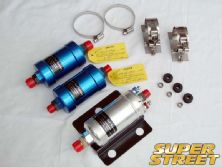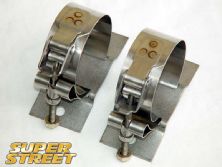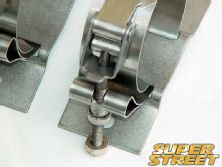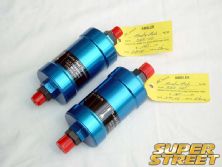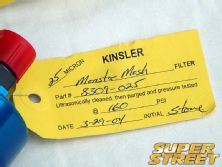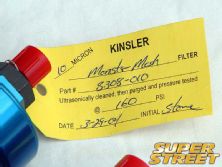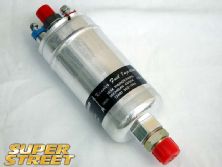The Porsche 911 Twin Turbo and Toyota Supra Twin Turbo both have 'em. Yes, they both have turbos. They also have bulletproof fuel pumps. Obviously, each of these cars make 2-3 times more power than your Honda. Now, both the 911 and Supra can belt out 400 hp without any type of fuel system modification. The in-tank pumps that come from the factory on most Hondas are designed for all-motor use, whereas the pumps on the 911 and Supra are obviously built and sized for their turbocharged state. The armatures and commutators inside the pump are larger, lending to this improved reliability. Think of a Honda fuel pump as a one of those tiny motors inside your Oral-B electric toothbrush. Well, a Supra or 911 fuel pump would be comparable to the winch on your pop's Jeep. Fuel pumps hibernating in the tanks of many 911s are made by Bosch, while the Supra's pump is made by Denso (formerly known as Nippon Denso). These OEM pumps are very reliable. More importantly, they sustain fuel pressure reliably when the boost is turned up.
Now, if you decide to purchase a turbo-kit, chances are it will come complete with an inline fuel pump. This is acceptable to a certain degree. What about the people that are building a custom turbo system for their rides? They can either purchase the same inline pump that came with the turbo-kit, or they can do what we're gonna do. Read on.
Think about it: the main reason you are going custom is because a) you want higher quality parts that aren't offered in kits and b) you're shooting for over 350 hp. If you're aiming for that type of power, an upgraded fuel pump is a necessity.
Now that you know you need a fuel pump, who should you call? If you want things done right the first time, call a company that specializes in fuel systems. After discussing our turbo system setup with Arturo Ortiz from Laskey Racing, we decided to give Kinsler Fuel Injection of Troy, Michigan a call. They've been in business since 1967, and this is the umpteenth time we've heard their name when discussing fuel pumps. They must know their stuff. Before you call them, be sure you have your current fuel system modifications mapped out. Specs such as engine size, injector flow rate, engine management system, and intended usage for the vehicle are all key factors in choosing the correct fuel pump for your turbocharged ride.
Here's our example:
- Engine size: 2000cc
- Injector size/number: 880cc x 4
- Engine management: stand alone
- Usage: Mile + road race + street driven 1-2 times a week
- HP goal: 450 measured at the wheels
Click on page 2 for more...
It was 9pm after we got off the phone with Art, so we emailed Kinsler. The next day, we got a call from one of their tech reps. After discussing what our goals and intentions were, they recommended a Kinsler high pressure electric fuel pump (p/n 10211). The pump's diameter is 2.36" and is 6.69" long, which might be a tad too big to fit in the stock Honda tank. Three options are available for those who want to use an in-tank pump: 1) shorten the body of the pump by one inch, 2) use an external inline pump, or 3) use one of Kinsler's smaller fuel pumps. Since we already figured that the pump was going to be employed as an inline, we told Kinsler just that. The cool thing is that the 10211 can be used as an in-tank or inline. Knowing this, Kinsler also recommended a set of trick ultra-high quality inline fuel filters (p/n 8308-010, 8309-025). The filters are anodized in a deep blue hue(see sidebar photos), and it's a shame that they're going to be mounted under the car.
Each filter is ultrasonically cleaned, purged, and pressure tested. Wow. Again, this is to ensure quality and reliability. The reason why we were sent two different fuel filters was because the fuel supply coming from the tank is theoretically "dirtier" than the fuel coming out of the fuel pump. Variances in fuel quality can be high at certain stations and/or times of the year. The inlet filter installed before the pump has a 25 micron screen while the outlet filter has a smaller, 10 micron screen. Details like this ensure long-term reliability. We also opted for the mounting kits for both the pump (p/n 10232) and filters (p/n 8300) and were impressed by the quality.
The pump itself is hefty (2.5 lbs), and can easily shatter a windshield at twenty paces. But the only thing we're going to be shattering is the myths associated with making power and torque with non-VTEC engines. Another important piece to our built LS motor will have the VTEC cognoscenti puzzled.
Stay tuned to Super Street Online for more on our turbo system buildup. For the install on the Kinsler fuel upgrade, look for the story in an upcoming issue of Super Street Magazine. We're also thinking of upgrading our turbo to a ball bearing unit...maybe.

